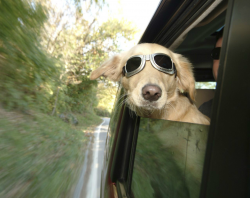
— Anyone who has ever driven with a pet in their car knows what it's like. You're driving 65 mph, Fido is running wild, and you're trying to drive safely to keep from killing him, yourself, and others.
Many consumers believe the answer is a pet restraint to keep the pooch off your dashboard and safe and sound in a seat. Manufacturers of these products proudly proclaim how their products have passed safety testing, but a new study says those claims don't really mean much.
Reason 1,001 Not To Trust Manufacturers
Lindsey Wolko founded the nonprofit Center for Pet Safety (CPS) after her dog was seriously injured when Wolko slammed on the brakes to avoid an accident.
Her dog was in a restraint, but the English cocker spaniel still flew into the back of the driver's seat. The beloved pet suffered spine and hip injuries and had her back legs wrapped in the safety harness.
Wolko later discovered there was no uniform testing methods for pet safety products for cars.
All that is beginning to change since her organization teamed with automaker Subaru to test pet restraints under real-world conditions.
Bring in the Crash Test Pups
Subaru and CPS hired MGA Research Corporation, an independent National Highway Traffic Safety Administration contracted testing laboratory, to perform crash testing on commonly available pet safety harnesses using specially designed crash test dogs.
The test dogs included a realistic 25 lb. terrier mix, a 45 lb. border collie and a 75 lb. golden retriever.
Researchers wanted to know answers to basic safety questions about pet restraints:
- Does the harness fail to the point the pet becomes a dangerous projectile in the car?
- If a product manufacturer claims a restraint passed testing, does that mean every size animal would be included?
- Does the test dog stay on the seat for the entirety of the crash test?
- Long harness tethers are known to be dangerous, so can they be adjusted to a length of 6” or less?
Researchers were shocked at how badly many of the products failed during testing. Some restraints completely failed to the point the pet would have been killed.
According to a statement from Subaru:
"The crash tests uncovered serious flaws in many of the popular pet restraints currently on the market, with many resulting in catastrophic failure."
And the pet safety harness winner is...
Overall results of the testing put Sleepypod’s Clickit Utility Harness as the clear winner. Researchers said it was the only harness to consistently keep a dog from launching off of the seat and the only restraint that offered substantial protection to passengers.
“Sleepypod has been researching and crash testing pet safety restraints in autos for six years because we’re serious about safety,” said Michael Leung, Sleepypod co-founder and product designer. “We admire CPS and Subaru for conducting this study on behalf of pet owners and use the CPS testing protocols as an extension of our own safety program.”
This new study is hopefully the first of many that will help to keep both pets and passengers safer in a crash. Far too many people have survived a crash only to find out their restrained pet did not.
“I, like many people, consider my dog to be a part of my family, and dogs need to be secured with harnesses that have been tested for safety the same way car seats and seat belts that protect our family members have been tested, both for the pet’s safety as well as the safety of all passengers,” said CPS founder, Lindsey Wolko.




